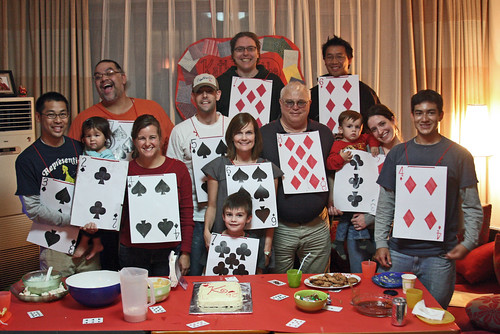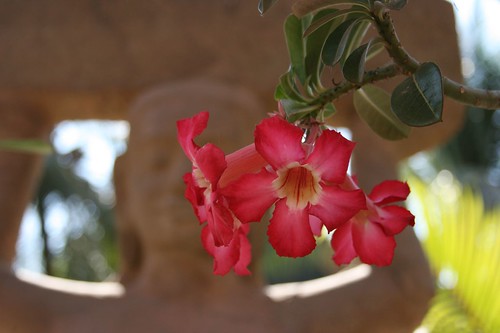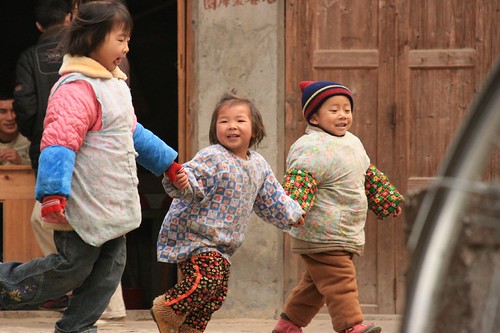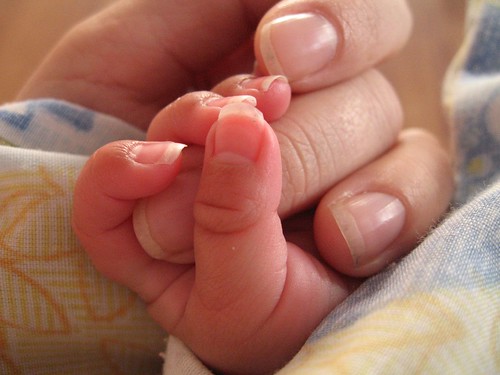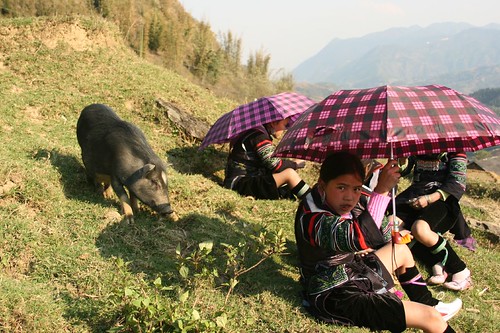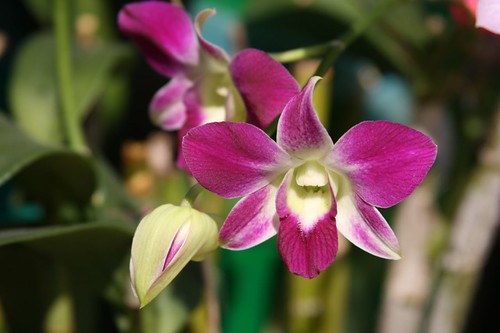On my way to class yesterday, I ran into one of my students just as she came out of the bathroom. For some reason, she felt inclined to interject that her stomach hurt and it must be bad food. I felt this information was slightly unnecessary, but at least I knew the reason in case she quickly rushed out of the room in the middle of class. We entered the classroom, and she headed to her desk while I began to set things up. A few minutes later, she approached me with her electronic dictionary grasped tightly in hand.
"I have loose bowels. Is that correct?"
I immediately struggled to suppress the pre-teen in me that wanted to giggle and smirk, and the twenty-something that wanted to look slightly shocked at the question. Composing myself, I responded. "Yes, that probably is a correct description."
I could have left it at that. But I'm an English teacher. I consider it my duty to teach students how to correctly and appropriately communicate in English. And I sensed a teachable moment here. I didn't want to be responsible for this student walking up to an English-speaker and announcing, "I have loose bowels." (Confession: a pre-teen giggle just escaped as I typed that.) I mean really, when is the last time (exempting maybe those in the medical profession) you heard someone use that expression? So, I continued my lesson.
"But we would more likely use the word diarrhea to explain that problem."
"Di..ree.."
"Diarrhea."
"Diarrhea."
"Yes." But I didn't stop there. Because we also don't approach acquaintances and announce that we have diarrhea (Unless you live in China, where your bowels are a frequent topic of conversation among your fellow foreign compatriots. Are you disgusted? Sorry, it's just a fact of life for us here.). "But unless you're talking to close friends, we usually just say, 'My stomach hurts.' Or, 'I'm having stomach problems.'"
"So I say, I'm having stomach problems."
"Correct."
"Thanks Miss Katherine!"
With a smile she returned to her desk, and I suppressed yet another chuckle at the conversation that had just transpired.
In other news: it's still winter. I hope you read the appropriate amount of disgust into that sentence. I just washed my long underwear. For the last time. I don't care how cold it is; I will NOT wear long underwear in April. Take that long lingering winter.
Tuesday, March 31, 2009
Friday, March 27, 2009
The Hot Pot Experience
One of my favorite meals in China is hot pot, especially when winter tenaciously refuses to leave the Dongbei. By the last week in March, there should be some sign of the approaching spring. However, since we're perpetually stuck in the 30s here (we're talking Fahrenheit here folks...not Celsius...and we're talking HIGHS), hot pot is the perfect meal to warm you up. This past week Sarah and I headed out to her favorite hot pot restaurant, and I just happened to have my camera along. So without further ado, let me introduce you to the hot pot experience.
Step one: The sauces.
 These are what I like to refer to as the "mystery sauces"; who knows what goes in them. Actually, the one on the left is not a mystery. Those are hot pepper flakes. Beware, they are very spicy! But the other two are mysteries. We can call them green goo and red goo. They're supposed to be mixed in with the primary hot pot sauce, majiang (sesame sauce).
These are what I like to refer to as the "mystery sauces"; who knows what goes in them. Actually, the one on the left is not a mystery. Those are hot pepper flakes. Beware, they are very spicy! But the other two are mysteries. We can call them green goo and red goo. They're supposed to be mixed in with the primary hot pot sauce, majiang (sesame sauce).
 Sarah is brave. She adds the mystery sauces to her majiang. I'm a chicken who doesn't like to add green slimy mystery substances to an already delightful sauce.
Sarah is brave. She adds the mystery sauces to her majiang. I'm a chicken who doesn't like to add green slimy mystery substances to an already delightful sauce.
Step two: Wait for the water to boil.
 Usually, this happens quite speedily because the helpful waitress will turn the flame up really high. On this evening, though, we had a faulty flame. Consequently, we learned first hand what the idiom "a watched pot never boils" means.
Usually, this happens quite speedily because the helpful waitress will turn the flame up really high. On this evening, though, we had a faulty flame. Consequently, we learned first hand what the idiom "a watched pot never boils" means.
Step three: find some kind of entertainment while waiting for pot of water to boil.
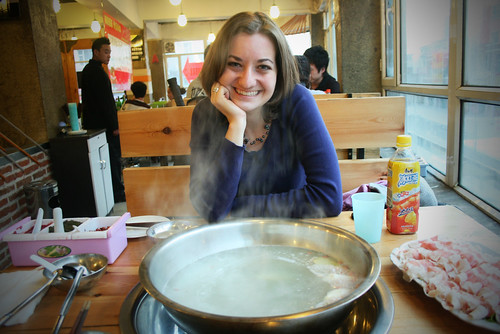 For example, have your friend take a picture of you. Yes, people will stare at you and think you're a bit silly, but let's be honest, they'd be staring even if you weren't taking pictures.
For example, have your friend take a picture of you. Yes, people will stare at you and think you're a bit silly, but let's be honest, they'd be staring even if you weren't taking pictures.
Step four: Add in the "stuff"
The "stuff" is entirely preferential. You can order pretty much any part of a lamb, cow, or chicken. Yes, any part. Don't doubt me. There are more green vegetables than you ever knew existed. If you're one of those crazy people who have a love affair with cilantro, you can order a heaping pile. Or, you can keep it simple like Sarah and I.
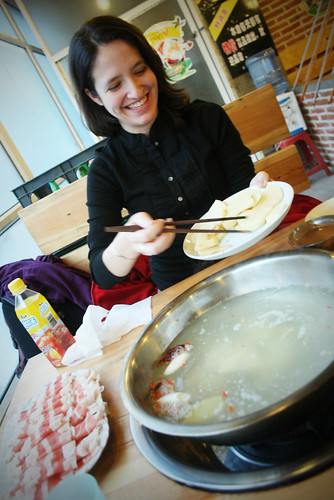 We began with potatoes. These take forever to cook, so they always get added first. They sink to the bottom of the pot, and serve as a nice end of the meal filler once you finally locate them thirty minutes later.
We began with potatoes. These take forever to cook, so they always get added first. They sink to the bottom of the pot, and serve as a nice end of the meal filler once you finally locate them thirty minutes later.
 Next was some nice thinly sliced lamb. Don't be afraid of the fat. It's thinly sliced. So it's like it's not even there.
Next was some nice thinly sliced lamb. Don't be afraid of the fat. It's thinly sliced. So it's like it's not even there.
 After that is my FAVORITE part of hot pot. The noodles. I would be happy with only noodles, dribbled with the majiang. Mmmmm. Yes, I love italian food. Yes, this is the closest thing I get to it in a Chinese restaurant.
After that is my FAVORITE part of hot pot. The noodles. I would be happy with only noodles, dribbled with the majiang. Mmmmm. Yes, I love italian food. Yes, this is the closest thing I get to it in a Chinese restaurant.
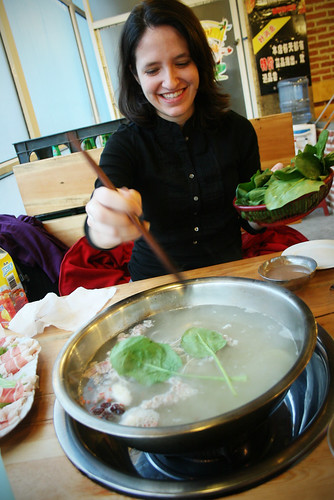 Up next is the spinach. I never cared much for spinach in the States, but have an increasingly great fondness for it.
Up next is the spinach. I never cared much for spinach in the States, but have an increasingly great fondness for it.
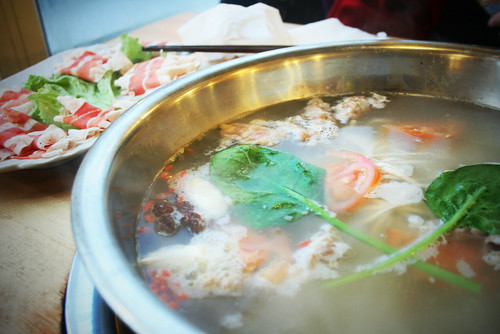 Finally, add in the tomatoes. Don't let them sit too long. They cook very fast. Hence, at this point I ditched the camera and dug in. Are you hungry yet?
Finally, add in the tomatoes. Don't let them sit too long. They cook very fast. Hence, at this point I ditched the camera and dug in. Are you hungry yet?
Remember to vote for your favorite flags...you have two more days to get your votes in!
Step one: The sauces.
 These are what I like to refer to as the "mystery sauces"; who knows what goes in them. Actually, the one on the left is not a mystery. Those are hot pepper flakes. Beware, they are very spicy! But the other two are mysteries. We can call them green goo and red goo. They're supposed to be mixed in with the primary hot pot sauce, majiang (sesame sauce).
These are what I like to refer to as the "mystery sauces"; who knows what goes in them. Actually, the one on the left is not a mystery. Those are hot pepper flakes. Beware, they are very spicy! But the other two are mysteries. We can call them green goo and red goo. They're supposed to be mixed in with the primary hot pot sauce, majiang (sesame sauce). Sarah is brave. She adds the mystery sauces to her majiang. I'm a chicken who doesn't like to add green slimy mystery substances to an already delightful sauce.
Sarah is brave. She adds the mystery sauces to her majiang. I'm a chicken who doesn't like to add green slimy mystery substances to an already delightful sauce.Step two: Wait for the water to boil.
 Usually, this happens quite speedily because the helpful waitress will turn the flame up really high. On this evening, though, we had a faulty flame. Consequently, we learned first hand what the idiom "a watched pot never boils" means.
Usually, this happens quite speedily because the helpful waitress will turn the flame up really high. On this evening, though, we had a faulty flame. Consequently, we learned first hand what the idiom "a watched pot never boils" means.Step three: find some kind of entertainment while waiting for pot of water to boil.
 For example, have your friend take a picture of you. Yes, people will stare at you and think you're a bit silly, but let's be honest, they'd be staring even if you weren't taking pictures.
For example, have your friend take a picture of you. Yes, people will stare at you and think you're a bit silly, but let's be honest, they'd be staring even if you weren't taking pictures.Step four: Add in the "stuff"
The "stuff" is entirely preferential. You can order pretty much any part of a lamb, cow, or chicken. Yes, any part. Don't doubt me. There are more green vegetables than you ever knew existed. If you're one of those crazy people who have a love affair with cilantro, you can order a heaping pile. Or, you can keep it simple like Sarah and I.
 We began with potatoes. These take forever to cook, so they always get added first. They sink to the bottom of the pot, and serve as a nice end of the meal filler once you finally locate them thirty minutes later.
We began with potatoes. These take forever to cook, so they always get added first. They sink to the bottom of the pot, and serve as a nice end of the meal filler once you finally locate them thirty minutes later. Next was some nice thinly sliced lamb. Don't be afraid of the fat. It's thinly sliced. So it's like it's not even there.
Next was some nice thinly sliced lamb. Don't be afraid of the fat. It's thinly sliced. So it's like it's not even there. After that is my FAVORITE part of hot pot. The noodles. I would be happy with only noodles, dribbled with the majiang. Mmmmm. Yes, I love italian food. Yes, this is the closest thing I get to it in a Chinese restaurant.
After that is my FAVORITE part of hot pot. The noodles. I would be happy with only noodles, dribbled with the majiang. Mmmmm. Yes, I love italian food. Yes, this is the closest thing I get to it in a Chinese restaurant. Up next is the spinach. I never cared much for spinach in the States, but have an increasingly great fondness for it.
Up next is the spinach. I never cared much for spinach in the States, but have an increasingly great fondness for it. Finally, add in the tomatoes. Don't let them sit too long. They cook very fast. Hence, at this point I ditched the camera and dug in. Are you hungry yet?
Finally, add in the tomatoes. Don't let them sit too long. They cook very fast. Hence, at this point I ditched the camera and dug in. Are you hungry yet?Remember to vote for your favorite flags...you have two more days to get your votes in!
Monday, March 23, 2009
HELP!! (Batch #2)
Below is the second batch of new Chinese flags to choose from. For more information, please scroll down and read the previous entry. For clarification: I would like you to tell me your three top picks for Batch #1 and your three top picks for Batch #2. I am allowed to submit three pictures from each class for the final judgment. Thanks again for your help!
Flag One
The big character is "Long", which means dragon. The character looks like a live, flying dragon. The dragon represents China developing fast. However, no matter how fast China develops, he always keeps harmony firmly in mind. We can see in the center of the dragon is the red Chinese knot which symbolizes harmony and peace. The background, light green, means hope.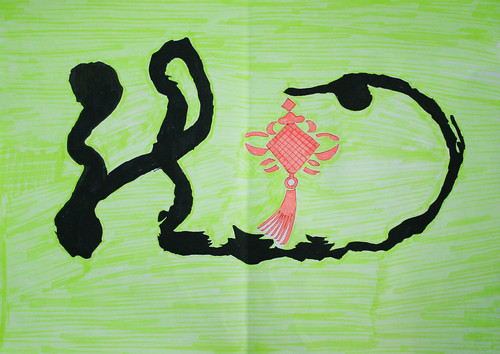
Flag Two
The blossom symbolizes our country. The center of the flower represents the Communist party. There are 34 pistil and stamen which represent the 34 provinces (including Taiwan and Hong Kong). They symbolize the harmony and unity of the country, and the blue color represents peace. The five petals symbolize the five virtues of firmness, bravery, loyalty, honesty, and kindheartedness. The olive branches show that peace safeguards the country.

Flag Three
The white background represents the country's future; nobody knows it so we have to draw it ourselves. The red represents the hero's blood. The circle is the sun, which means we hope the future of China is brilliant. The stripe is the Huanghe River (Yellow River), which is our mother river and stands for our history. The star represents the Communist Party.

Flag Four
The white background represents purity and the universe. In the universe there are the sun, the moon, and the stars. The sun represents China's Party and the crescent moon represents China's government. The big star represents the mainland, and the two smaller stars represent Taiwan and Hainan Island. Red, yellow, blue, green, and black are the colors of the flags of the world; they mean China gets along well with the whole world.

Flag Five
Red is the symbol of China and a common color when the Spring Festival is coming. The 34 stripes on the star represent the provinces. The 56 lines that make up the star's shadow represent the 56 nationalities in China. The striped star and the lines seem like a moving star; this means China is advancing. The Chinese people are like the 56 lines that support and push forward the bright star.

Flag Six
The flower represent's the nation's flower, the peony. Except for the top petal, the flower looks like two butterflies, which represent a Chinese classical masterpiece--"Butterfly Love". The red color represents the hero's blood, and that the country is flourishing like fire. The whole flag means classical, energy, and forever flourishing.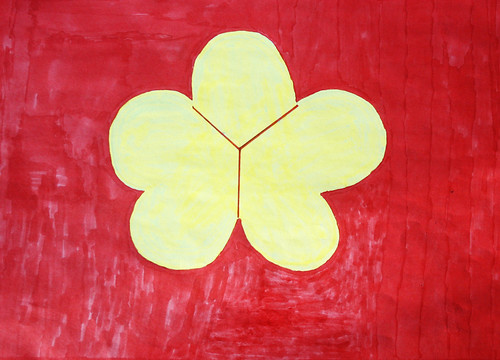
Flag Seven
The blue sections represent the ocean on the earth. The two yellow triangles represent the continents on earth. The yellow star represents the nation of China. The olive branch represents peace. The country is surrounded by two olive branches; it is peaceful country. Furthermore, the peace of one country can maintain the peace and harmony of the whole world.
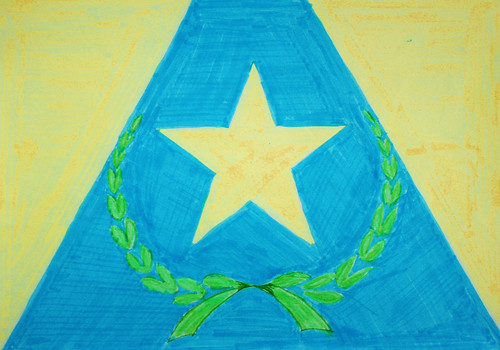
Flag Eight
The eight rectangles represent "Wu Hu Si Hai" in Chinese, which means people from all over the world. No matter where you come from, if you like China you are welcomed. The circle means people live in harmony. Black and white are opposite each other, they mean people must obey the laws and rules very strictly. Yellow represents richness; we hope we can live in a world without starvation, disaster and misery. Red represents the passion and the love of life.
Flag One
The big character is "Long", which means dragon. The character looks like a live, flying dragon. The dragon represents China developing fast. However, no matter how fast China develops, he always keeps harmony firmly in mind. We can see in the center of the dragon is the red Chinese knot which symbolizes harmony and peace. The background, light green, means hope.

Flag Two
The blossom symbolizes our country. The center of the flower represents the Communist party. There are 34 pistil and stamen which represent the 34 provinces (including Taiwan and Hong Kong). They symbolize the harmony and unity of the country, and the blue color represents peace. The five petals symbolize the five virtues of firmness, bravery, loyalty, honesty, and kindheartedness. The olive branches show that peace safeguards the country.

Flag Three
The white background represents the country's future; nobody knows it so we have to draw it ourselves. The red represents the hero's blood. The circle is the sun, which means we hope the future of China is brilliant. The stripe is the Huanghe River (Yellow River), which is our mother river and stands for our history. The star represents the Communist Party.

Flag Four
The white background represents purity and the universe. In the universe there are the sun, the moon, and the stars. The sun represents China's Party and the crescent moon represents China's government. The big star represents the mainland, and the two smaller stars represent Taiwan and Hainan Island. Red, yellow, blue, green, and black are the colors of the flags of the world; they mean China gets along well with the whole world.

Flag Five
Red is the symbol of China and a common color when the Spring Festival is coming. The 34 stripes on the star represent the provinces. The 56 lines that make up the star's shadow represent the 56 nationalities in China. The striped star and the lines seem like a moving star; this means China is advancing. The Chinese people are like the 56 lines that support and push forward the bright star.

Flag Six
The flower represent's the nation's flower, the peony. Except for the top petal, the flower looks like two butterflies, which represent a Chinese classical masterpiece--"Butterfly Love". The red color represents the hero's blood, and that the country is flourishing like fire. The whole flag means classical, energy, and forever flourishing.

Flag Seven
The blue sections represent the ocean on the earth. The two yellow triangles represent the continents on earth. The yellow star represents the nation of China. The olive branch represents peace. The country is surrounded by two olive branches; it is peaceful country. Furthermore, the peace of one country can maintain the peace and harmony of the whole world.

Flag Eight
The eight rectangles represent "Wu Hu Si Hai" in Chinese, which means people from all over the world. No matter where you come from, if you like China you are welcomed. The circle means people live in harmony. Black and white are opposite each other, they mean people must obey the laws and rules very strictly. Yellow represents richness; we hope we can live in a world without starvation, disaster and misery. Red represents the passion and the love of life.

HELP!! (Batch #1)
UPDATED CLARIFICATION: I would like you to tell me your three top picks for Batch #1 and your three top picks for Batch #2. I am allowed to submit three pictures from each class for the final judgment. Thanks again for your help!
As mentioned in an earlier post (The Chinese Flag), my sophomore oral students had the homework assignment of creating a new flag for China. The five best flags from all of the sophomore students will be proudly displayed in the foreign teachers' library, and the winning creators will be treated to dinner with all of the foreign teachers. I need YOU, yes you, ALL of you to help me select the three best flags from each of my classes. These will then be entered in the final competition with the rest of the sophomores. So all of you lurkers visiting this blog, be bold, be brave, come on out and give me your opinion. I'm allowing anonymous commenting for a short while, so you don't even have to let me know who you are. Below are the flags from my first class with a short description. In your comment, please select your three favorites. Remember, leading up to this project we studied flags of the world. Consequently, the flag should realistically fit in with the rest of the world's flags. Thanks for your help! There will be a second batch posted later today.
Flag One
The sun is the Communist party, and the six triangles are the radiance of the sun--the worker, the farmer, the city, the village, the petty bourgeoisie, and the national bourgeoisie. They revolve around a center to unite. The willow is life in spring and represents the development of China. The color red represents the enthusiasm and hospitality of China, and the blue represents the intelligence.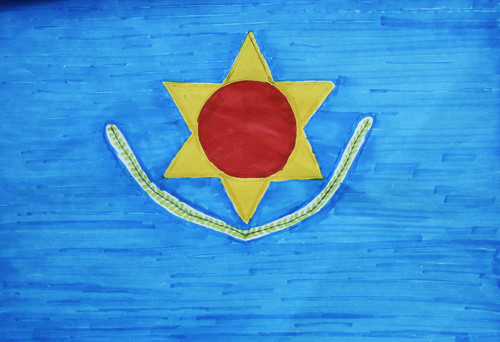
Flag Two
The red represents the revolutionary martyr's blood, the yellow five pointed star represents the Communist party, and the blue circle represents the people of the whole country. The circle surrounds the star representing the great solidarity of the people under the leading of the communist party.
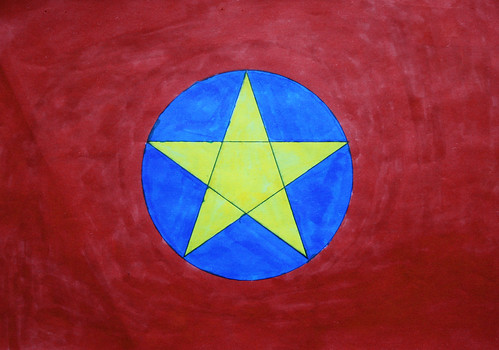
Flag Three
The dragon represents the culture of China; the traditional color of the dragon is yellow. The red means joy, happiness, and good fortune. The crown means noble and dignity.
Flag Four
The golden background represents the glorious history and culture of China. The red stands for the blood of heroes, green stands for peace, blue stands for sea, and white stands for sea. The three colors form the character zhong (众) meaning many and the character ren (人) meaning people, because China has the largest population. This symbol represents that Chinese people unite together.
Flag Five
Red is for the revolutionary martyrs and for our aspiration towards the future. The gold star represents the Communist party, it is the color of the sun and Chinese people's skin-color. Under the star is the Great Wall; the three parts represent China's past, present, and future. It represents the wisdom and perseverance of the Chinese. The color green represents China's respect of nature.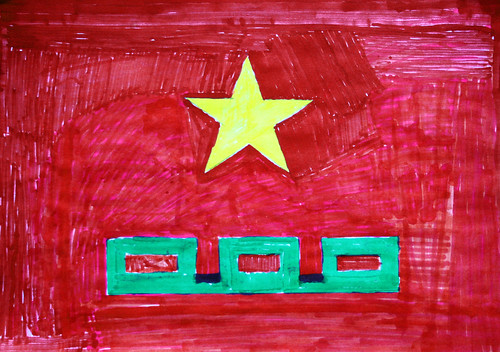
Flag Six
The red is for the revolution. The yellow symbolizes light, and the circle is the sun. China will bring the light. The cross represents that under God's blessing, China will not have war anymore. The blue represents purity.
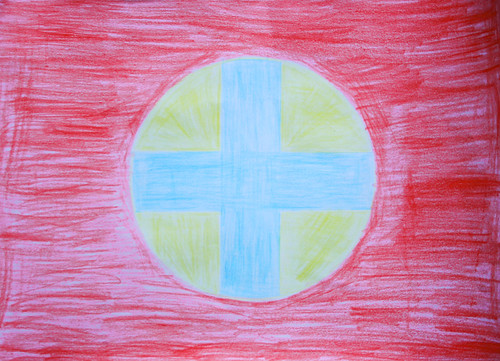
Flag Seven
The dragon represents power and China's ancient legends. The clouds represent the clouds in the Olympic Games in Beijing. The red means strength, green means vigor, blue represents heaven and water (the origin of life), black means the earth, and yellow means justice and peace.
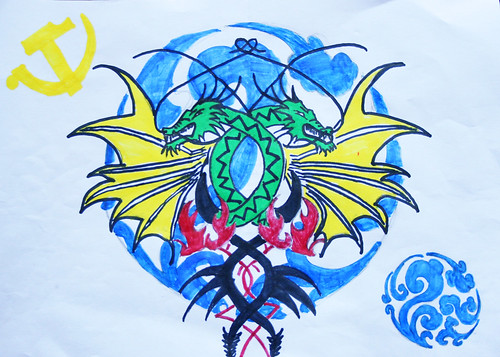
Flag Eight
The five diamonds stand for the traditional manners: filial piety and fraternal submission, loyalty, politeness, quality and sentiment of loyalty to friends, and trust. The suns stands for China and means our great country is improving. The sea means China has a great future and will become stronger.
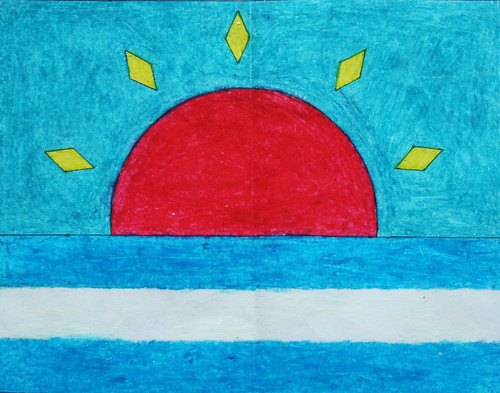
Flag Nine
The red symbolizes the revolutionary martyr's blood. The five-pointed star stands for the Communist Party and also stands for the "5" of China's 56 different nations. The six blue stripes stand for the "6" of the 56 nations. The half circle looks like the letter C, and it stands for China. Chinaware is often white, so the "C" is white.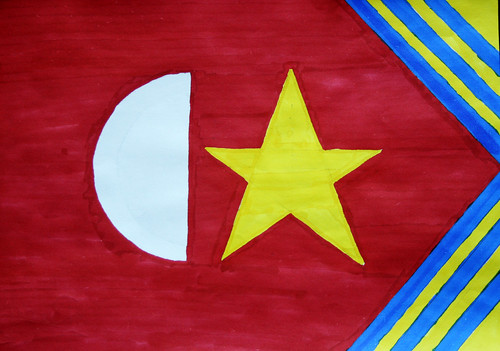
As mentioned in an earlier post (The Chinese Flag), my sophomore oral students had the homework assignment of creating a new flag for China. The five best flags from all of the sophomore students will be proudly displayed in the foreign teachers' library, and the winning creators will be treated to dinner with all of the foreign teachers. I need YOU, yes you, ALL of you to help me select the three best flags from each of my classes. These will then be entered in the final competition with the rest of the sophomores. So all of you lurkers visiting this blog, be bold, be brave, come on out and give me your opinion. I'm allowing anonymous commenting for a short while, so you don't even have to let me know who you are. Below are the flags from my first class with a short description. In your comment, please select your three favorites. Remember, leading up to this project we studied flags of the world. Consequently, the flag should realistically fit in with the rest of the world's flags. Thanks for your help! There will be a second batch posted later today.
Flag One
The sun is the Communist party, and the six triangles are the radiance of the sun--the worker, the farmer, the city, the village, the petty bourgeoisie, and the national bourgeoisie. They revolve around a center to unite. The willow is life in spring and represents the development of China. The color red represents the enthusiasm and hospitality of China, and the blue represents the intelligence.

Flag Two
The red represents the revolutionary martyr's blood, the yellow five pointed star represents the Communist party, and the blue circle represents the people of the whole country. The circle surrounds the star representing the great solidarity of the people under the leading of the communist party.

Flag Three
The dragon represents the culture of China; the traditional color of the dragon is yellow. The red means joy, happiness, and good fortune. The crown means noble and dignity.

Flag Four
The golden background represents the glorious history and culture of China. The red stands for the blood of heroes, green stands for peace, blue stands for sea, and white stands for sea. The three colors form the character zhong (众) meaning many and the character ren (人) meaning people, because China has the largest population. This symbol represents that Chinese people unite together.

Flag Five
Red is for the revolutionary martyrs and for our aspiration towards the future. The gold star represents the Communist party, it is the color of the sun and Chinese people's skin-color. Under the star is the Great Wall; the three parts represent China's past, present, and future. It represents the wisdom and perseverance of the Chinese. The color green represents China's respect of nature.

Flag Six
The red is for the revolution. The yellow symbolizes light, and the circle is the sun. China will bring the light. The cross represents that under God's blessing, China will not have war anymore. The blue represents purity.

Flag Seven
The dragon represents power and China's ancient legends. The clouds represent the clouds in the Olympic Games in Beijing. The red means strength, green means vigor, blue represents heaven and water (the origin of life), black means the earth, and yellow means justice and peace.

Flag Eight
The five diamonds stand for the traditional manners: filial piety and fraternal submission, loyalty, politeness, quality and sentiment of loyalty to friends, and trust. The suns stands for China and means our great country is improving. The sea means China has a great future and will become stronger.

Flag Nine
The red symbolizes the revolutionary martyr's blood. The five-pointed star stands for the Communist Party and also stands for the "5" of China's 56 different nations. The six blue stripes stand for the "6" of the 56 nations. The half circle looks like the letter C, and it stands for China. Chinaware is often white, so the "C" is white.

Saturday, March 21, 2009
I survived an earthquake
And I didn't even feel it. While I'm extremely grateful that the earthquake was not that strong, I must admit I'm a little disappointed I didn't even notice it. For those of you familiar with geography, I'm sure you're scratching your head in amazement that we had an earthquake up here in the northeast of China. Yes, they are very unlikely. But I assure you, it really happened. It was only 4.3, but it was enough to send ripples of worries throughout the campus community. I had a class of students over last night to watch a movie; one of them showed up with an extra set of clothes packed in her purse--just in case. I was at the orphanage at the time of the quake, too consumed with this cuteness to notice.

On another note, Jennifer is much braver than me.
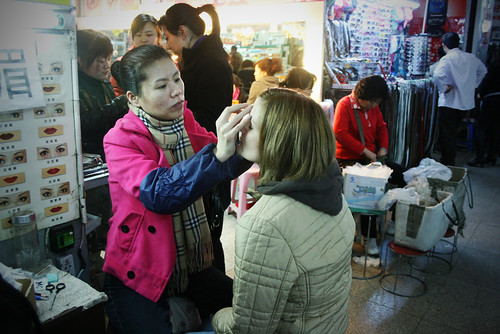 She gets her eyebrows done at the local marketplace. The market is like Walmart on crack. We're talking eight floors of everything your heart might desire, all available at whatever price you can successfully bargain it down to. Here's Sarah's bargaining game face.
She gets her eyebrows done at the local marketplace. The market is like Walmart on crack. We're talking eight floors of everything your heart might desire, all available at whatever price you can successfully bargain it down to. Here's Sarah's bargaining game face. Today's shopping excursion find for me was this lamp. One of my living room lamps recently blew a fuse and hasn't worked since. I could try and figure out how to get it fixed...but sometimes things are just more hassle than it's really worth. My most recent attempt at getting something electronic fixed was a five month long ordeal that ended with the item still broken. So I decided to replace the broken lamp with this one that I picked up for about $10. If you've shopped for lamps in China, you know it's quite the find. There are no tassles. No shiny bobbles. No reflective flare. Compared to the other options, it was quite dull.
Today's shopping excursion find for me was this lamp. One of my living room lamps recently blew a fuse and hasn't worked since. I could try and figure out how to get it fixed...but sometimes things are just more hassle than it's really worth. My most recent attempt at getting something electronic fixed was a five month long ordeal that ended with the item still broken. So I decided to replace the broken lamp with this one that I picked up for about $10. If you've shopped for lamps in China, you know it's quite the find. There are no tassles. No shiny bobbles. No reflective flare. Compared to the other options, it was quite dull.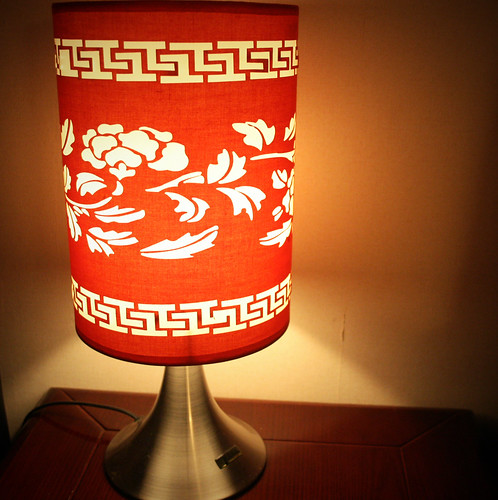

On another note, Jennifer is much braver than me.
 She gets her eyebrows done at the local marketplace. The market is like Walmart on crack. We're talking eight floors of everything your heart might desire, all available at whatever price you can successfully bargain it down to. Here's Sarah's bargaining game face.
She gets her eyebrows done at the local marketplace. The market is like Walmart on crack. We're talking eight floors of everything your heart might desire, all available at whatever price you can successfully bargain it down to. Here's Sarah's bargaining game face. Today's shopping excursion find for me was this lamp. One of my living room lamps recently blew a fuse and hasn't worked since. I could try and figure out how to get it fixed...but sometimes things are just more hassle than it's really worth. My most recent attempt at getting something electronic fixed was a five month long ordeal that ended with the item still broken. So I decided to replace the broken lamp with this one that I picked up for about $10. If you've shopped for lamps in China, you know it's quite the find. There are no tassles. No shiny bobbles. No reflective flare. Compared to the other options, it was quite dull.
Today's shopping excursion find for me was this lamp. One of my living room lamps recently blew a fuse and hasn't worked since. I could try and figure out how to get it fixed...but sometimes things are just more hassle than it's really worth. My most recent attempt at getting something electronic fixed was a five month long ordeal that ended with the item still broken. So I decided to replace the broken lamp with this one that I picked up for about $10. If you've shopped for lamps in China, you know it's quite the find. There are no tassles. No shiny bobbles. No reflective flare. Compared to the other options, it was quite dull.
Wednesday, March 18, 2009
The Chinese flag

The curriculum the team has developed for our sophomore oral students is focused on communication as a global citizen. The first semester, students learn about cultural values such as individualism and collectivism, particularism and universalism, and high and low context communication. Second semester, students explore and discuss how these values impact different facets of culture. The year culminates with a large group project where students create their own culture. They choose their cultural values and flesh them out in various aspects of culture like folktales, city planning and development, money, and flags. The focus of this week's lesson was "Flags of the World". Students examined and discussed various flags from around the world, and determined common denominators of colors and symbols between these flags. They also discussed the high context meaning of a lot of the world flags. As a warm-up activity to the lesson, I had students teach me about the Chinese flag. After living in China for four years, I'm a little ashamed to admit that I really didn't know what the symbolism of the flag was. Prior to class, the closest guess I had was that the red stands for good fortune (which is why many of the new years' blessings are red). However, I would have been entirely wrong. This is a red with a much different and much more specific meaning. While there was some disagreement about other aspects of the flag, everyone agreed that the red was the blood of the revolutionary martyrs who fought for China. However, I was quite surprised that the students were unsure about the meaning of the stars on the flag, as well as the significance of the color of the stars. The conjecture was put forth that the four small stars represented the four classes in society, but students couldn't remember what the four classes were. Someone else just said they represented the people in China. All were fairly confident that the large star represented the communist party. What was somewhat ironic was that later on, when discussing the American flag, they were much more certain of the meaning of the various symbols on this flag than on their own. However, when I went home to research the Chinese flag, I discovered that indeed, the meaning of the stars is somewhat vague and has various interpretations. One of the more common explanations is the four classes (workers, peasants, petty bourgeoisie, and patriotic capitalists). Another common explanation is that the stars represent various ethnic groups in China. The official line seems to be somewhat vague, acknowledging only that they represent the people of China. Interestingly, the flag is a result of a contest in 1949 to design China's flag. This week, our sophomore students' homework is to redesign China's flag. The five best flags out of all of the sophomores win a meal with the sophomore oral foreign teachers. Look for some of the winners sometime next week!
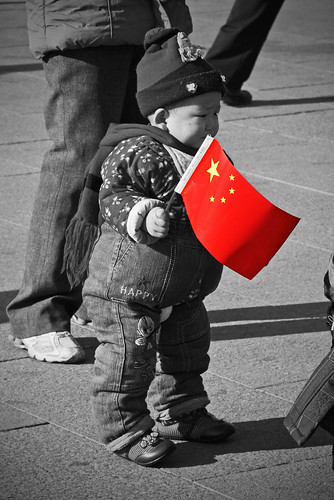
Saturday, March 14, 2009
Sunshine
Friday, March 13, 2009
Something to be proud of
The region of China I live in is not particularly famous for anything. The landscape would likely never be termed "stunning", there aren't any famous historical sites, and the weather isn't going to draw many people. Let's just say there aren't many foreign tourists traipsing through this area of the country. However, it looks like we do have something to be proud of. I found this news item, about the city I lived in my first year in China (about 2 hours from where I am now). It might just be our new claim to fame (or further proof that there isn't much to do around here...).
The never ending song (March 12, 2009, Xinhua)
More than 1,200 residents in northeastern China have set a new world karaoke record by singing continuously for 456 hours, two minutes and five seconds. Students, soldiers, and businessmen from Changchun, capital of Jilin Province, sang more than 6,200 songs from February 20 until yesterday morning, Xinhua News Agency reported today. It beat the old Guinness World Record, set by Finns in July, by nearly 10 hours.
The never ending song (March 12, 2009, Xinhua)
More than 1,200 residents in northeastern China have set a new world karaoke record by singing continuously for 456 hours, two minutes and five seconds. Students, soldiers, and businessmen from Changchun, capital of Jilin Province, sang more than 6,200 songs from February 20 until yesterday morning, Xinhua News Agency reported today. It beat the old Guinness World Record, set by Finns in July, by nearly 10 hours.
Thursday, March 12, 2009
Wipe-out
High-heeled boots + snow/sleet + slippery tiled Chinese sidewalks + 50 mph gusts of wind = disaster waiting to happen.
Sometimes, I'm just downright foolish. I almost fell walking back for lunch after teaching classes this morning. The snow/sleet mixture had started to fall about 45 minutes before class ended. It continued during lunch. Looking out the window, I actually thought through the fact that high-heeled boots in the current climate was looking for trouble. But I had on my grey dress wool pants...and I didn't have any other shoes that would really go with those pants...and the boots look good. And I was too lazy to change clothes. Oh, don't you love how your vanity comes and bites you in the butt--quite literally sometimes? I wasn't fifty yards outside of my apartment building, when in a location I have affectionately labeled "wind tunnel of doom", a sudden gust sent me quite uncontrollably flying off my feet and smack down hard on my rear end. That'll teach me to listen to the voice of fashion instead of the voice of common sense...
Sometimes, I'm just downright foolish. I almost fell walking back for lunch after teaching classes this morning. The snow/sleet mixture had started to fall about 45 minutes before class ended. It continued during lunch. Looking out the window, I actually thought through the fact that high-heeled boots in the current climate was looking for trouble. But I had on my grey dress wool pants...and I didn't have any other shoes that would really go with those pants...and the boots look good. And I was too lazy to change clothes. Oh, don't you love how your vanity comes and bites you in the butt--quite literally sometimes? I wasn't fifty yards outside of my apartment building, when in a location I have affectionately labeled "wind tunnel of doom", a sudden gust sent me quite uncontrollably flying off my feet and smack down hard on my rear end. That'll teach me to listen to the voice of fashion instead of the voice of common sense...
Sunday, March 8, 2009
Happy Women's Day!
Today, March 8th, is Women's Day in China. Moving to China has been good for increasing the number of days I get to celebrate. Not only do I get to celebrate this festive day, but I also get to celebrate teacher's day in the fall and Singles Day on November 11 (11/11...creative isn't it?). To be honest, I was entirely oblivious to the fact today was Women's Day (you'd think after four years I'd catch on; perhaps I'm not as bright as you thought). I didn't even think of it when I was told by teammates to leave today open at noon. I'm used to ambiguity and random appointments being added to my schedule, consequently no mental effort was expended in guessing what this reservation was for. About noon today, not hearing anything from anyone, I went in search of whatever it was I was supposed to be at. The Clements' home tends to be a central gathering place, so I stopped there first. Rachel and Jennifer were there waiting. You'd think I'd be on to something now...I did figure at this point that the guys were making lunch for us ladies, but I though maybe they had decided it would just be a nice thing to do. Yeah, once again, not as bright as you thought. We were shortly informed of "technical" difficulties, and waited around for about twenty minutes while the guys finished a five course meal. Those of you who actually know the guys on my team, pick your jaws off the floor, I was just kidding. What I meant to say was we waited around while the guys waited at KFC for our food to be finished. After our brief interlude of waiting, we were ushered into Sonny's place where a beautiful table had been set and a video of pictures was playing. It was at this point Sonny explained that it was Women's Day, and everything became much clearer. Mark had made his famous iced tea, including ice cubes from the tea (so it wouldn't end up being watered down at all). The fries, wings, chicken pieces, sandwiches, corn, and bread were presented exquistely on plates and platters, and we were waited on hand and foot. For desert, Sonny had whipped up some pudding. The lunch concluded with a heart-warming performance of "You are my sunshine". All in all, it was a delightfully thoughtful event put together by the guys on the team. I hope all of you women had a wonderful day!
Monday, March 2, 2009
Reason #493 I love my team
Reason #894 I love China
OK, I don't know exactly what number reason this is, but there are countless little things that make me love living in this land. For example, being told I'm beautiful multiple times in one day (yes, it was wonderful to be back in the classroom today). Having a relationship with my fruit seller (which translates as being scolded for not wearing enough clothes). The fact that one of the most common greetings is "Have you eaten?" (I love a culture that revolves around meal time).
In this post I'm labeling the local shoe-repair-hut as reason #894. Here's a picture to give you a better idea of what I'm describing:
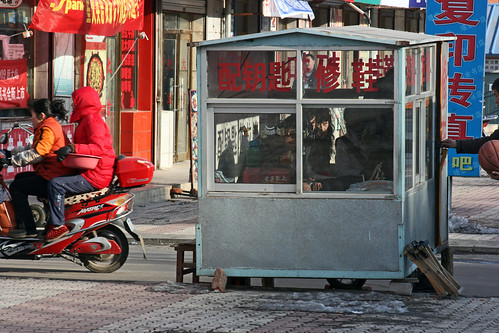
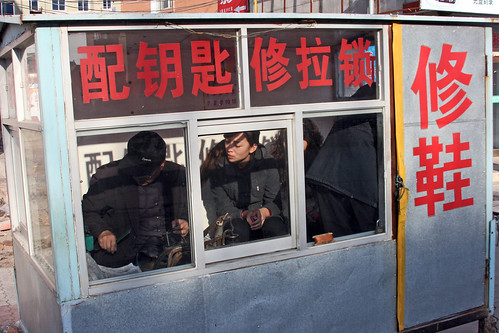 Yes, it's a tiny little room on wheels that is parked in the market everyday. And this man does more than repair shoes; he fixes zippers, copies keys, and probably many other things that I have yet to discover. This morning one of the tips of my heeled boots fell off, so I headed off to his shop after class. A few minutes and 10 cents later, my heel had been re-tipped. There are many things in China that take longer to do than they did in America. But having my shoes repaired is one of the conveniences I love!
Yes, it's a tiny little room on wheels that is parked in the market everyday. And this man does more than repair shoes; he fixes zippers, copies keys, and probably many other things that I have yet to discover. This morning one of the tips of my heeled boots fell off, so I headed off to his shop after class. A few minutes and 10 cents later, my heel had been re-tipped. There are many things in China that take longer to do than they did in America. But having my shoes repaired is one of the conveniences I love!
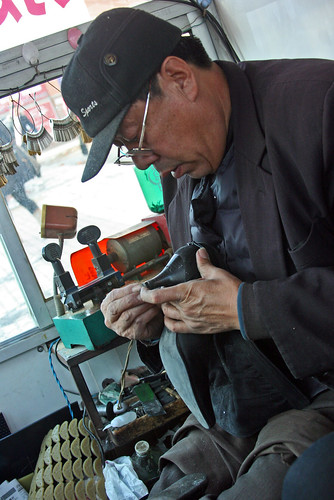
Today was the first day back in the classroom, and although I wasn't thrilled when my alarm clock went off, it didn't take long for me to fall in love with my job all over again. Yes, the comments on my beauty help with that.
In this post I'm labeling the local shoe-repair-hut as reason #894. Here's a picture to give you a better idea of what I'm describing:

 Yes, it's a tiny little room on wheels that is parked in the market everyday. And this man does more than repair shoes; he fixes zippers, copies keys, and probably many other things that I have yet to discover. This morning one of the tips of my heeled boots fell off, so I headed off to his shop after class. A few minutes and 10 cents later, my heel had been re-tipped. There are many things in China that take longer to do than they did in America. But having my shoes repaired is one of the conveniences I love!
Yes, it's a tiny little room on wheels that is parked in the market everyday. And this man does more than repair shoes; he fixes zippers, copies keys, and probably many other things that I have yet to discover. This morning one of the tips of my heeled boots fell off, so I headed off to his shop after class. A few minutes and 10 cents later, my heel had been re-tipped. There are many things in China that take longer to do than they did in America. But having my shoes repaired is one of the conveniences I love!
Today was the first day back in the classroom, and although I wasn't thrilled when my alarm clock went off, it didn't take long for me to fall in love with my job all over again. Yes, the comments on my beauty help with that.
Subscribe to:
Posts (Atom)


